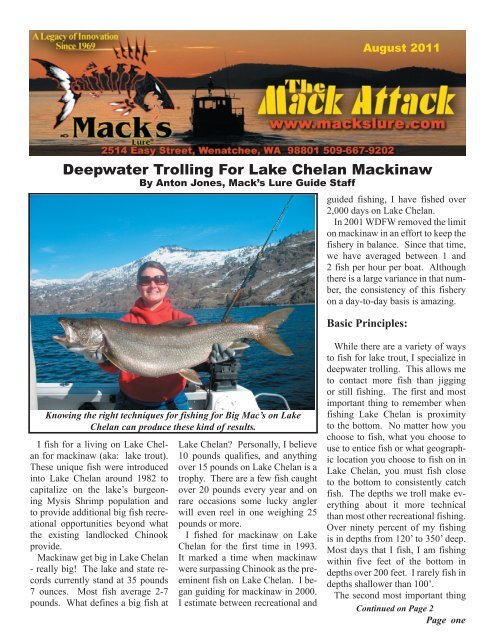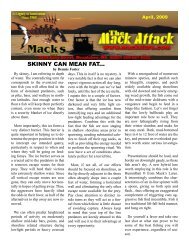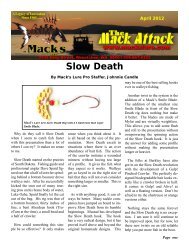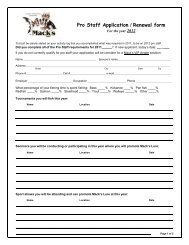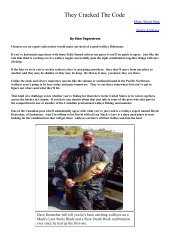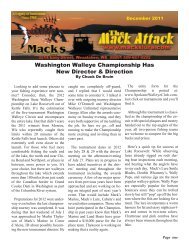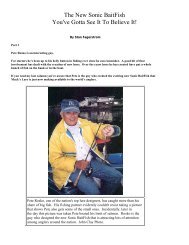Deepwater Trolling For Lake Chelan Mackinaw - Mack's Lure
Deepwater Trolling For Lake Chelan Mackinaw - Mack's Lure
Deepwater Trolling For Lake Chelan Mackinaw - Mack's Lure
Create successful ePaper yourself
Turn your PDF publications into a flip-book with our unique Google optimized e-Paper software.
Continued from Page 1for this deepwater trolling applicationis speed control. Because of thedepths we fish, it can be difficult tomaintain that correct “fish catching”speed. Drag created by the gear youare trolling and wind can greatly affectyour speed. Remember eachlure or bait that you troll with has anoptimal speed. To consistently andeffectively troll them you must be atthat speed. Some lures have a verynarrow range of effectiveness.Something else to keep in mind isscent control. Remember that over200’ deep there is no light penetration.Therefore, mackinaw must usetheir sense of smell to locate and attackprey. Don’t let your trolled lureor bait have a “bad” smell on it!Tools of the trade:A boat that is laid out well, and isseaworthy enough to handle threefootwaves in windy conditions iswhat you want. The boat should beequipped with a high-powered depthfinder,electric downriggers and away of monitoring your speed. Whilenot necessary, a Autopilot will makeyour life a lot easier. I have a depthfinderwith 8000 watts of powerand a 10.5-inch screen. This allowsme to identify fish and bottom densitywell below 400 feet with a highdegree of certainty. Electric downriggersare the most efficient way tohelp you maintain that proximity tothe bottom, which is the prime directiveon <strong>Lake</strong> <strong>Chelan</strong>. I have usedelectric downriggers since the mid‘90’s and have found them suitedto the task. I spool them up withmore than 500’ of 200# test, attacha 12-pound downrigger ball and aPro Release. You must constantlytouch the bottom and raise the ballto maintain that tight proximity tothe bottom. Other methods such asmanual downriggers or using heavyweight attached to your fishing linewill tend to fatigue you.I use the GPS to monitor myspeed. Newer GPS units have finallyachieved reasonable accuracy below2mph. It’s additional capabilityof showing your map location,marking “hot spots” and allowingyou to precisely return to them areadditional advantages. The less expensiveoption is a mechanical speedindicator. The Auto pilot allows meto set a heading and a speed therebyallow me to focus more of my attentionon keeping the lures near thebottom by making more downriggeradjustments.I believe in long limber rods witha parabolic bend. I have used 9’light action rods for years and believethem well suited to the task.A reel should have a smooth dragand large cranking handle. A largenumber of mackinaw manage to getaway because they shake their headsas well as twist and turn which cantear hooks out of poorly hooked fishif they get the leverage to do it. Along limber rod and a light drag settingcan prevent fish from gettingthat leverage.I spool all our trolling reels with30# test. Because of its small diameterand low stretch, this super braidis the line we choose. The low diameterreduces the resistance in thewater, which lessens “blow-back”from the rod tip to the downriggerball. The lack of stretch allows us to“read” what is happening very accurately.I have found that by attachinga stiff mono leader to the braidbefore attaching a lure we increaseour bite rate. We choose 30# Fluroclearfor this task.Almost any lure or bait that youcan catch other game fish on can beused to catch mackinaw. The trickis to precisely present that lure at itsoptimal speed near the bottom ingreat depths. I highly recommendthat you initially use lures that functionwell at speeds less than 2 mphwith low drag. This lessens “blowback” and makes turning less complicated.Mack’s <strong>Lure</strong> Cha ChaSquidders in glow colors are a greatchoice. They feature a Smile Bladewhich definitely allows for the slowtrolling speeds and low drag.Locations:Remember, proximity to the bottomis more important than geographiclocation on <strong>Lake</strong> <strong>Chelan</strong>.With that being said, we fish primarilyin the lower basin of <strong>Lake</strong> <strong>Chelan</strong>,the bottom 15 miles of the 53-mile long lake. Our three primaryareas are: Mack Bar just off the MillBay boat launch; the trench, whichis the centerline of the lake that extendsdownlake from Rocky Pointfor approximately 1 mile and in theNarrows near the Yacht Club. Thatwill give you a start. The trench isthe kindest bottom for this style offishing. The area around the YachtClub will cost you the most geardue to a rocky and obstruction-ladenbottom. As you get confidence,there is plenty of fish and space todevelop your own locations.If you follow the outline presentedhere, you should be able to havesome success, begin to build confidenceand hopefully come to embracedeepwater trolling for <strong>Mackinaw</strong>on <strong>Lake</strong> <strong>Chelan</strong>.I’ll see you on the water.Page two
Stan’s SpacePractice Makes PerfectIt Also Puts More Fish InThe BoatBy Hall-of-Fame AnglerStan FagerstromPart 2 of 3Practice casting is certain to putmore fun into your fishing. It’s alsogoing to make it a whole lot morepleasant for your fishing companion.When I wrote my previous columnabout the importance of practice,I immediately thought of whata friend told me about a couple offriends he had taken along on fishingadventures, each at a differenttime.You can bet Joe Bullock, of California,knows how to match his tackle tothe problems he’s up against and thathe has practiced enough to be expert inusing whatever gear he selects. That’swhat lets him take huge bass like thismonster out of Mexico’s famed <strong>Lake</strong> ElSalto.“I asked both of these guys a fewquestions well ahead of the time wewere to leave,” he says. “I was toprovide the equipment and I neededto know what kind of gear theycould handle.”“Charlie, the first of the two Itook, assured me he was familiarwith both level wind reels as wellas open faced spinning reels. As aresult I put together four bait castingrigs and a couple of spinningoutfits. I asked him if he’d like todo a little practice casting before we-To Be Continuedleft.He assured me that wasn’t necessary.“How wrong that turned out tobe!” I doubt he had ever attempted tocast with a level wind reel. He nevereven picked up one of the outfits I’dbrought along for him. His experiencewith a spinning reel had evidentlybeen limited to trolling. He’sa heck of a good guy and I valuehis friendship, but if anybody couldhave used a little practice beforegetting on the water, it was him.See that submerged stump in theforeground? That’s where that basswas holding. The successful angler hadto get his lure in there just right to getthe fish to hit.“I well remember the reaction ofthe other friend who I invited to accompanyme on the same kind oftrip. I was again to provide all ofthe equipment we’d use once wegot there. “Jack,” this friend said,“any chance I could come down andspend a day or two with you beforewe go? I’ve not used a level windreel much and I’d like to practicewith it a bit if that works out foryou.”My friend went on to tell me howthe second of his two friends didcome to stay with him a day beforetheir departure for the trip. He setup a couple of targets out in his yardand gave this guy, his name wasBob, a couple of the same reels he’dbe using when they got to wherethey were going.You’d like Bob. I’d heard thathe was competitive in anything hetackled. He sure as heck was. In notime at all he was handling my levelwind reels like he’d been using themfor years.”It takes practice to learn how to use alevel wind reel successfully. The sooneryou accept that, and then do somethingabout it, the sooner you’ll be assured ofgetting your share of the fish.So what was the result of myfriend’s experience? If you’re an experiencedangler yourself, you couldundoubtedly guess. The first guy,the one who didn’t see the need forpractice, had an awful time. Whenhe wasn’t hung up in the trees, hewas picking at tangles. As a resulthe didn’t catch as many fish as heshould have.“That wasn’t how it went withBob,” my friend told me. “He was apleasure to have in the boat. He wasable to put his lure on target darnnear all the time. As it turned out,he caught more fish than I did and Ithink he went home happy about theentire experience.”I expect I’ve done about as muchpreaching about the importance ofcasting practice as anybody in thecountry. As I mentioned in my previouscolumn, I’ve been at it sinceI gave my first casting exhibitionmore than half a century ago.There’s no question about it, castingpractice is essential if you hopeto ever catch your share of fish. Thesooner you accept that, and do somethingabout it, the sooner you’ll jointhat 10 per cent of anglers who catchabout 90 per cent of the fish.There are certain steps to take thatcan be of great help if you do decideto practice your casting. I’ll detailwhat some of the important basicsare in my next column.Page three
Cookin’ YourGrilled <strong>Mackinaw</strong><strong>Lake</strong> Trout<strong>Mackinaw</strong> lake trout are verysimilar to the salmon. They areabundant in the waters of <strong>Lake</strong><strong>Chelan</strong>, Priest <strong>Lake</strong>, <strong>Lake</strong> Tahoe,and other area lakes. They have atender pink flesh that is very reminicentof the Salmon. Althoughthere are many ways to cook thisfish; baked, broiled, fried, grilled,poached and steamed, the recipebelow is one of my favorites. I liketo serve this with a Wild HuckleberrySauce.Ingredients:• Large lake trout, cleaned• 2 tablespoons oil• 1/4 cup freshly squeezed orangejuice• 1/2 cup fresh raspberries,huckleberries, or blueberries• 1 tablespoon fresh basilDirections:Place the trout on a large piece ofaluminum foil. Rub the trout withoil and season with salt and pepper.Pour orange juice over the trout.Place berries over the trout. Fold upthe aluminum foil to create a sealedpacket. Place the packet on the grilland cook for about 4 - 10 minutesper side (depending on the size ofyour fish). Remove from the grilland let rest for 5 minutes. Carefullyopen the foil packet (there will besteam) and sprinkle with the basil.LET’S EAT!!!Photo of the MonthQuestion of the MonthHave a question? We’d loveto answer it! Contact us atmackslure@mackslure.com if youhave a question you would like toQ: I recently watched, and enjoyed,a TV show on the Versus channelwhere they were fishing on Apache<strong>Lake</strong>. There was a rigging I sawwhich got my attention, a swimmingSenko with a Smile Blade infront of it. I was wondering if youcould explain how to rig it?A: That is a very effective way torig. Stan Fagerstrom did a great 3-part article about how to use and rigthe Smile Blades that way called“He Busts ‘Em with a Blade” and itis posted on the Mack’s <strong>Lure</strong> website.Go to Stan’s Corner, archives,2008. Part 3 has illustrations of therig as well. Here is a direct linkhttp://www.mackslure.com/index.php?c_ref=61The Mack Attack is a free serviceprovided to anyone who is interestedby Mack’s <strong>Lure</strong>, Inc. We needyour input! If you know of anyonewho would like to be on the mailinglist to receive the Mack Attack,please forward their e-mail addressto al@mackslure.com.Photos, stories and comments arewelcomed and encouraged. Pleaseforward all content materials tobob@mackslure.com.This 29 lb. 14 oz. <strong>Lake</strong> Trout was caught on <strong>Lake</strong> <strong>Chelan</strong> using a 1.9 GloGold Tiger Smile Blade. Photo submitted by Guide Joe Heinlen.Page four


